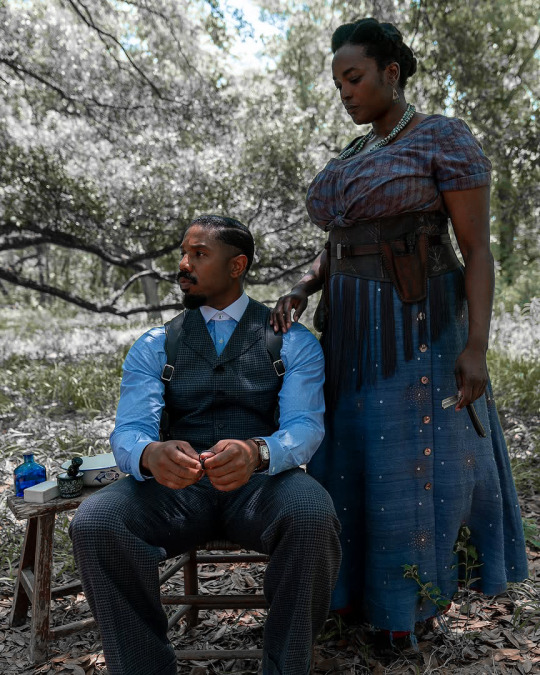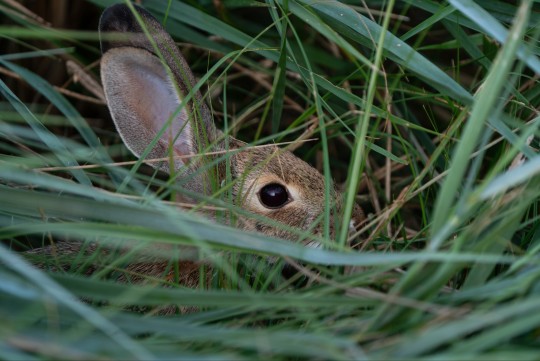One selfie per day. More or less. *IMPORTANT NOTE*: I tend to assume people are okay with their selfies being reblogged. But I will immediately remove any post, no questions asked, if its creator objects to it being here.
Don't wanna be here? Send us removal request.
Text

sinners: how real stories of irish and choctaw oppression inform the film
16K notes
·
View notes
Text
Haint Blue and Indigo: The Colors of Annie and Smoke
This is by no means an extensive history of haint blue and indigo*, but I just wanted to dip a bit into how much is said just by looking at one layer of costuming for Sinners. In this case color—how it's able to convey just how deeply rooted Annie is to her heritage/history, and to me, how this case of colors shows so beautifully Smoke's connection to Annie and his love for her.


"There's that haint blue that Annie lives around as part of a spiritual color. So I took the haint blue and used it in her clothes. I wanted her to have these layers. You first meet her [...] She's a community person. She's a healer, a spiritual leader." - Ruth E. Carter, Costume Design for Sinners (emphasis mine)
Haint blue is a color seen painted on porches, doorways and windows in the American South. As the name suggests, it was believed (though the oral histories are difficult to come by beyond the 30s), to ward off evil spirits. Using haint blue, according to the Gullah-Geechee, tricked evil spirts into thinking they had come across water or sky, bodies they were unable to cross, therefore deterring them from crossing over the blue.
Annie's costume was infused with this color; the blue on her cotton blouse and her skirt belted with feathers and beads. When we're introduced to Annie, her home has a collection of blues: from the wooden panelling, scraps of fabric hanging in the background, and blue bottles strewn about. This infusion of haint blue in her home is also a deliberate choice as talked about by production designer Hannah Beachler.
*Corrections, whether through comments or reblogs, for this post are definitely welcome! I cite my sources at the end of this long post.
This type of blue is not a specific color but rather, it becomes Haint Blue when it is used for the purpose of warding off haints, a belief rooted in Gullah-Geechee beliefs. (Though for technicalites' sake, it is a range of blues -> blue greens). After the 1800s, this way of using blue trickled down from the Gullah-Geechees in South Carolina to places such Louisina where Annie is suggested to be from.

The Old Plantation (Slaves Dancing on a South Carolina Plantation), ca. 1785-1795. watercolor on paper, attributed to John Rose, Beaufort County, South Carolina
Blue has always had a fraught history with enslaved Native Americans and Africans. The production of indigo was a profitable commodity demanded by the British empire as early as the 18th century. This production of indigo however, while it oppressed, was also a way for Black and Native Americans to express their individuality, and for people such as the Gullah-Geechee, their spirituality. Annie continues to draw strength from her roots and it's incredible to see it so profusely in so many aspects of her character, including her clothes.

So here is where I deviate a bit from "canon" per se, or give some interpretation of Ruth E.'s and Coogler's "Smoke is blue." We talk a lot about how the movie does a great job of showing how, though Smoke wasn't completely "sold" on hoodoo, but that he did very much believe in Annie. And that trust between them goes beyond what Smoke's willing to communicate through words (he wears the mojo bag through the war, through Chicago, and removes it only when he's ready to die. How he let's her take the reigns when talking to Cornbread. How he follows through with his promise as painful as it was).
"Smoke is blue. Stack is red." - Ruth E. Carter explaining how Ryan Coogler first posed the characters to her as a jumping off point for costuming.
Whether or not it's a conscious knowledge, I like to think that he dresses in blue as an extension of that trust. That bond between Annie and Smoke and the protection that comes with it bleeds into something as "ordinary" as Smoke's choice of color. One can say that maybe the color reminds him of Annie, and I also think there's some argument to be made about the universe answering Annie's prayers of protection, wrapping Smoke in an extra layer, another ward against evil.
----
Sources:
Blue Roots by Robert Pickney
Red, White and Black Make Blue: Indigo in the Fabric of Colonial South Carolina Life by Andrea Freeser
Haint Blue, the Ghost-Tricking Color of Southern Homes and Gullah Folktales
What the Color ‘Haint Blue’ Means to the Descendants of Enslaved Africans
Interviews of Ruth E. Carter and Hannah Beachler linked in the pull quotes above.
854 notes
·
View notes
Photo

Stephi! How wonderful to see you! Thank you for participating in Selfie Sunday, and thank you for being a member of PWS.
174 notes
·
View notes
Text
are you nerds ready to see TOP SURGERY KIRK??

22K notes
·
View notes
Text

some food for the daforge shippers 🙏🙏
(Source: Carey, Diane. Ghost Ship (Star Trek The Next Generation Book 1), 1988)
1K notes
·
View notes
Text

My Doordasher got a really good photo of Aster
1K notes
·
View notes
Text
Went to a Femtanyl concert recently (goddamn I love her music so much) and I took a nice picture of me so I guess you girls can finally see me :3 I got to meet Noelle!!! I love how about a third of the people there were transfem, I met so many awesome people and the show was crazy good

19 notes
·
View notes
Text

Omg Im hand stitching Girl Scout badges on to her vest while she’s at gymnastics. And you may ask yourself how did I get here
23 notes
·
View notes











